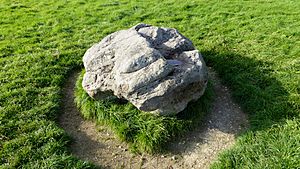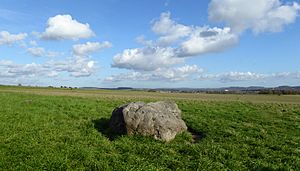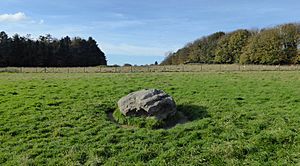Cuckoo Stone facts for kids
 |
|
|
Map showing the Cuckoo Stone within the Stonehenge section of the Stonehenge and Avebury World Heritage Site
|
|
| Location | OS SU1465433 |
|---|---|
| Region | Wiltshire |
| Coordinates | 51°11′21″N 1°47′30″W / 51.18923°N 1.79168°W |
| Type | Standing stone |
| History | |
| Periods | Neolithic / Bronze Age |
| Site notes | |
| Excavation dates | 2007 |
| Archaeologists | Stonehenge Riverside Project |
| Condition | Fallen |
| Public access | Yes |
| Designated | 1986 |
| Reference no. | 373 |
The Cuckoo Stone is a very old stone from the Stone Age or Bronze Age. It used to stand tall but has now fallen over. You can find it in a field in Wiltshire, England, close to other famous ancient sites like Woodhenge and Durrington Walls. It's an important part of the amazing Stonehenge Landscape.
Contents
What is the Cuckoo Stone?
The Cuckoo Stone is a large, heavy stone called a sarsen stone. These are the same type of huge stones used for the main circle at Stonehenge. The Cuckoo Stone now lies on its side in a field.
Where is the Cuckoo Stone Located?
This ancient stone is about 500 meters (about 1,640 feet) east of Woodhenge. It is also near Durrington Walls to the northeast. The famous Stonehenge monument is about 2.5 kilometers (about 1.5 miles) southwest.
An explorer named Richard Colt-Hoare first put the Cuckoo Stone on his map of the Stonehenge area in 1810. Another sarsen stone was found nearby at Woodhenge during digs in the 1920s.
Discoveries at the Cuckoo Stone
Archaeologists dug around the Cuckoo Stone in 2007. This dig was part of a bigger project called the Stonehenge Riverside Project. This project helps us learn more about the people who built Stonehenge and lived nearby.
How the Stone Was Used
The excavations showed where the Cuckoo Stone once stood upright. It was originally a natural stone, but people moved it into an upright position before 2000 BC.
Inside the hole where the stone stood, they found a mark from a wooden post. This means a wooden pole was there first, and later the Cuckoo Stone replaced it. Around 2000 BC, people started to use the Cuckoo Stone area for burials. They buried the ashes of people who had died (cremation burials) nearby.
Roman Era Discoveries
Much later, during the time of Roman rule (around 43 AD to 410 AD), a rectangular building was built near the Cuckoo Stone. This building was likely a small shrine. Archaeologists found pits and Roman coins, which suggests it was a place for worship.




